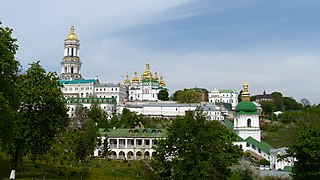
Kyiv is the capital and most populous city of Ukraine. It is in north-central Ukraine along the Dnieper River. As of 1 January 2022, its population was 2,952,301, making Kyiv the seventh-most populous city in Europe. Kyiv is an important industrial, scientific, educational, and cultural center in Eastern Europe. It is home to many high-tech industries, higher education institutions, and historical landmarks. The city has an extensive system of public transport and infrastructure, including the Kyiv Metro.
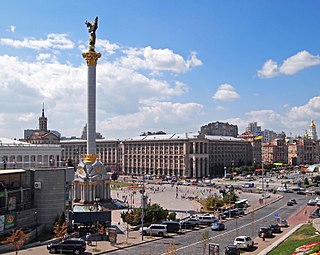
Maidan Nezalezhnosti (Ukrainian: Майдан Незалежності, IPA:[mɐjˈdɑnnezɐˈɫɛʒnosti] or Independence Square is the central town square of Kyiv, the capital city of Ukraine. One of the city's main squares, it is located on Khreshchatyk Street in the Shevchenko Raion. The square contains the iconic Independence Monument.

Hotel Ukraine, also referred to as Hotel Ukraina or Hotel Ukrayina, is a four-star hotel located in central Kyiv, the capital of Ukraine. It was built in 1961 as the Hotel "Moscow" in a location which originally was occupied by Kyiv's first skyscraper, the Ginzburg House. The construction of the hotel finished the architectural ensemble of Kyiv's main street – the Khreshchatyk – which formed the post-war reconstruction of central Kyiv. The hotel is state-owned and belongs to the State Management of Affairs.
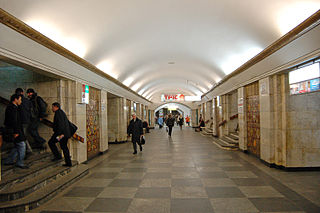
Khreshchatyk is a station on the Sviatoshynsko-Brovarska Line of the Kyiv Metro. The station is named for the Khreshchatyk street, the most central street in Kyiv. The station was opened in 1960 along with the first stage of the Metro. It The station is pylon trivault that features ceramic Ukrainian ornaments framed by metallic grills on the central hall sides of the pylons. White marble is used elsewhere, particularly for the walls and the main pylon frames. The ceiling is covered in white plaster and lighting comes from hidden lamps in the niches of the central vault and a central row of lamps.

Maidan Nezalezhnosti is a station on Kyiv Metro's Obolonsko–Teremkivska line. The station was opened on 17 December 1976, and is named after Kyiv's Maidan Nezalezhnosti on the Khreshchatyk street. It was designed by N. Kolomiiets, I. Maslenkov, M. Syrkyn, and F. Zaremba.
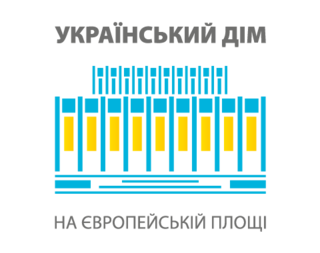
The Ukrainian House International Convention Center, is the largest international exhibition and convention center in Kyiv, Ukraine. The five-storey building is the host venue for a variety of events from exhibitions, trade fairs and conferences to international association meetings, product launches, banquets, TV-ceremonies, sporting events, etc.

The Kyiv City Duma building housed the Kyiv City Duma before World War II. The building was located on the then Dumskaya Ploschad of the Khreschatyk street in Kyiv and stood in the centre of it.

Prorizna Street is a street located in central Kyiv, Ukraine.

The Bessarabska Square is a square located at the southwest end of Khreshchatyk, the main thoroughfare of Kyiv, the capital of Ukraine. It is located in the city's Shevchenkivskyi District (district), at the busy intersection of Khreshchatyk, Taras Shevchenko Boulevard, Velyka Vasylkivska Street, and the Krutyi Descent streets.

Euromaidan, or the Maidan Uprising, was a wave of demonstrations and civil unrest in Ukraine, which began on 21 November 2013 with large protests in Maidan Nezalezhnosti in Kyiv. The protests were sparked by President Viktor Yanukovych's sudden decision not to sign the European Union–Ukraine Association Agreement, instead choosing closer ties to Russia and the Eurasian Economic Union. Ukraine's parliament had overwhelmingly approved of finalizing the Agreement with the EU, but Russia had put pressure on Ukraine to reject it. The scope of the protests widened, with calls for the resignation of Yanukovych and the Azarov government. Protesters opposed what they saw as widespread government corruption, abuse of power, human rights violations, and the influence of oligarchs. Transparency International named Yanukovych as the top example of corruption in the world. The violent dispersal of protesters on 30 November caused further anger. Euromaidan was the largest democratic mass movement in Europe since 1989 and led to the 2014 Revolution of Dignity.
Below are the domestic responses to the Euromaidan. Euromaidan was a wave of demonstrations and civil unrest in Ukraine that began on the night of 21 November 2013 after the Ukrainian government suspended preparations for signing an Association Agreement and Deep and Comprehensive Free Trade Agreement with the European Union.

The Trade Unions Building, or Budynok Profspilok, is a large office building in Kyiv, Ukraine. Located on the city's main Khreshchatyk Street, its façade faces the central Maidan Nezalezhnosti square and contains the city's main clock tower.
In response to a police crackdown on Euromaidan's protesters in the early hours of 30 November, more than half a million Kyivans joined the protests on 1 December in order to defend the students "and to protect society in the face of crippling authoritarianism."
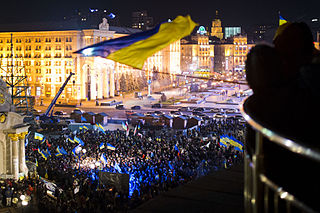
Euromaidan was a wave of demonstrations and civil unrest in Ukraine, which began on the night of 21 November 2013 with large public protests demanding closer European integration. Protesters also stated they joined because of the dispersal of protesters on 30 November and "a will to change life in Ukraine". The scope of the protests evolved over subsequent months, and by 25 January 2014 the protests were fueled by the perception of widespread government corruption, abuse of power, and violation of human rights in Ukraine. By February 2014 the protests had largely escalated into violence, resulting in the Revolution of Dignity and the resignation of Azarov's government and ousting of President Yanukovych. This resulted in the outbreak of the Russo-Ukrainian War.
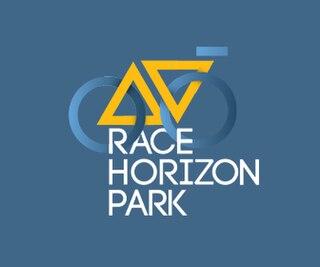
Race Horizon Park is an international cycling road race, held annually in the capital of Ukraine, during the celebration of the Day of Kyiv. As a part of the bicycle race, a traditional parade of amateur cyclists is held as well – Bicycle Day.

Hotel Dnipro is a four-star hotel located in central Kyiv, the capital of Ukraine, on European Square, next to Khreschatyk Street and near Maidan Nezalezhnosti.
The Metrohrad is an extensive underground shopping mall at Bessarabska Square, Kyiv, Ukraine.

The 2010 Kyiv Victory Day Parade was held on May 9, 2010, in Kyiv, honoring the 65th anniversary of the Soviet Union's victory in the Great Patriotic War. Military vehicles and soldiers dressed in Soviet Army uniforms marched on Khreschatyk Street and through Maidan Nezalezhnosti. Inspecting the parade was the Chief of the General Staff of the Armed Forces General of the Army Ivan Svyda while the commander of the Ukrainian Ground Forces, Colonel General Henadii Vorobiov commanded the parade. The decree for holding the parade was signed on 23 March of that year. The President of Ukraine Viktor Yanukovych delivered a jubilee address in his position as Supreme Commander. 2,500 members of the Ukrainian Armed Forces as well as troops from Russia and Belarus took part in the parade. 17 military bands took part in the parade under the command of the Chief of the Military Music Department of the General Staff of the Ukrainian Armed Forces, Major General Volodymyr Derkach.

The 60th Anniversary of the Liberation of Ukraine was a celebration in Kyiv, Ukraine on October 27–28, 2004 on the occasion of the 60th anniversary of the liberation of Ukraine from the Nazi Invaders. It was notable in that it was timed to the 2004 Ukrainian presidential election that occurred a week later. It was the first time the anniversary was celebrated since independence.

The 70th Anniversary of the Liberation of Kyiv was a celebration in Kyiv, Ukraine, on November 6, 2013, on the occasion of the 70th anniversary of the liberation of Kyiv from the Nazi Invaders.

























